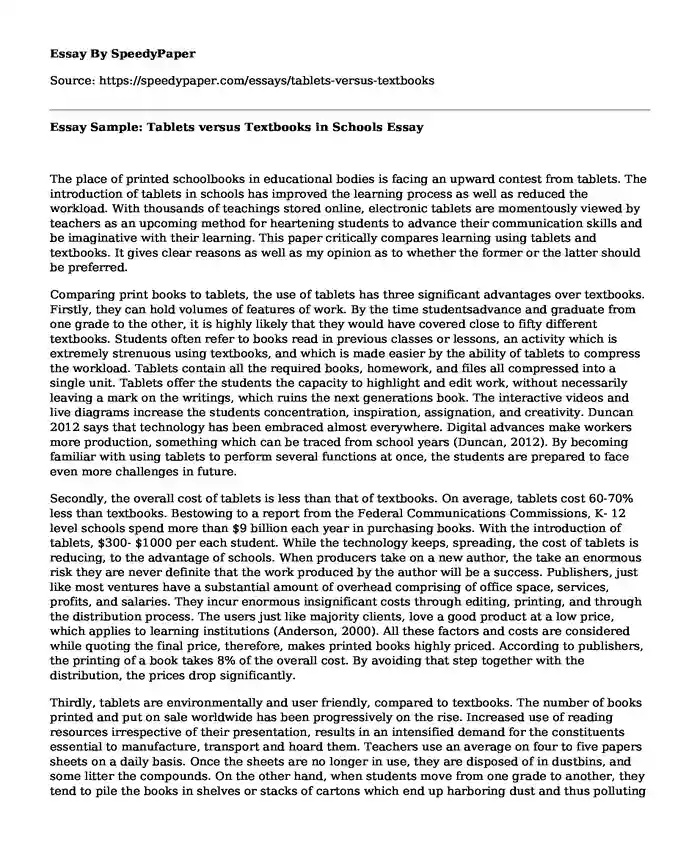The place of printed schoolbooks in educational bodies is facing an upward contest from tablets. The introduction of tablets in schools has improved the learning process as well as reduced the workload. With thousands of teachings stored online, electronic tablets are momentously viewed by teachers as an upcoming method for heartening students to advance their communication skills and be imaginative with their learning. This paper critically compares learning using tablets and textbooks. It gives clear reasons as well as my opinion as to whether the former or the latter should be preferred.
Comparing print books to tablets, the use of tablets has three significant advantages over textbooks. Firstly, they can hold volumes of features of work. By the time studentsadvance and graduate from one grade to the other, it is highly likely that they would have covered close to fifty different textbooks. Students often refer to books read in previous classes or lessons, an activity which is extremely strenuous using textbooks, and which is made easier by the ability of tablets to compress the workload. Tablets contain all the required books, homework, and files all compressed into a single unit. Tablets offer the students the capacity to highlight and edit work, without necessarily leaving a mark on the writings, which ruins the next generations book. The interactive videos and live diagrams increase the students concentration, inspiration, assignation, and creativity. Duncan 2012 says that technology has been embraced almost everywhere. Digital advances make workers more production, something which can be traced from school years (Duncan, 2012). By becoming familiar with using tablets to perform several functions at once, the students are prepared to face even more challenges in future.
Secondly, the overall cost of tablets is less than that of textbooks. On average, tablets cost 60-70% less than textbooks. Bestowing to a report from the Federal Communications Commissions, K- 12 level schools spend more than $9 billion each year in purchasing books. With the introduction of tablets, $300- $1000 per each student. While the technology keeps, spreading, the cost of tablets is reducing, to the advantage of schools. When producers take on a new author, the take an enormous risk they are never definite that the work produced by the author will be a success. Publishers, just like most ventures have a substantial amount of overhead comprising of office space, services, profits, and salaries. They incur enormous insignificant costs through editing, printing, and through the distribution process. The users just like majority clients, love a good product at a low price, which applies to learning institutions (Anderson, 2000). All these factors and costs are considered while quoting the final price, therefore, makes printed books highly priced. According to publishers, the printing of a book takes 8% of the overall cost. By avoiding that step together with the distribution, the prices drop significantly.
Thirdly, tablets are environmentally and user friendly, compared to textbooks. The number of books printed and put on sale worldwide has been progressively on the rise. Increased use of reading resources irrespective of their presentation, results in an intensified demand for the constituents essential to manufacture, transport and hoard them. Teachers use an average on four to five papers sheets on a daily basis. Once the sheets are no longer in use, they are disposed of in dustbins, and some litter the compounds. On the other hand, when students move from one grade to another, they tend to pile the books in shelves or stacks of cartons which end up harboring dust and thus polluting the environment in the long term. Additionally, the education system keeps on changing, different editions of the same version of a book do crowd and increases the pollution level. Producing a single book costs two to three-kilowatt hours of fossil fuel and carbon dioxide of approximately 20% more that from the green house. This contributes highly to environmental pollution since more books have to be produced continuously for a single institution. For the tablets, all one is required to keep on updating the content. When the device is worn out (which rarely happens), it is replaced with a new device which takes years to get worn out (Ark, 2010).
I do support the use of tablets over textbooks for the reasons given. Technology is not only impressive, but it opens more avenues in which students could learn, information is readily available, and referencing is quite easy. We are living in a generation of more technologically savvy people, and it is important that students get to familiarize themselves with technology at an early age. Education is gradually shifting from approving inputs to focusing on students outcomes. The quantity and quality of teaching openings online are exploding. Therefore the sooner schools upgrade from print textbooks to E-textbooks, the better.
References
Anderson, A. (2000). Should Your School Replace Textbooks with E-Readers? Newyork City: Edweek Publishers.
Ark, T. V. (2010). Post Textbook World. New York: Smart Press.
Duncan, A. (2012). Digital Textbook Playbook. Mexico: Portland Press.
Cite this page
Essay Sample: Tablets versus Textbooks in Schools. (2019, Sep 24). Retrieved from https://speedypaper.com/essays/tablets-versus-textbooks
Request Removal
If you are the original author of this essay and no longer wish to have it published on the SpeedyPaper website, please click below to request its removal:
- Thesis Paper Example: Cash Management Problem Statement
- Free Essay Example on Internet of Things
- Formalist Criticism of The Dead Man's Path. Literary Essay Sample.
- Essay Example about American Civil Liberties Union and How It Impacted the American Culture
- Essay Example: Overall Picture of My Values and Ethics
- Free Essay. My Idea of Perfect Happiness
- Learning Styles & Saint Leo Values - Free Paper
Popular categories





